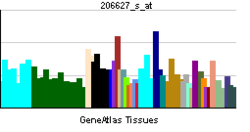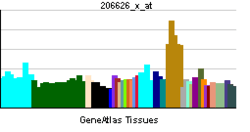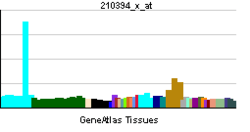SSX1
| Synovial sarcoma, X breakpoint 1 | |||||||||||||
|---|---|---|---|---|---|---|---|---|---|---|---|---|---|
| Identifiers | |||||||||||||
| Symbols | SSX1 ; CT5.1; SSRC | ||||||||||||
| External IDs | OMIM: 312820 HomoloGene: 136735 GeneCards: SSX1 Gene | ||||||||||||
| |||||||||||||
| RNA expression pattern | |||||||||||||
 | |||||||||||||
 | |||||||||||||
 | |||||||||||||
| More reference expression data | |||||||||||||
| Orthologs | |||||||||||||
| Species | Human | Mouse | |||||||||||
| Entrez | 6756 | 387132 | |||||||||||
| Ensembl | ENSG00000126752 | ENSMUSG00000023165 | |||||||||||
| UniProt | Q16384 | Q80ZT4 | |||||||||||
| RefSeq (mRNA) | NM_001278691 | NM_001001450 | |||||||||||
| RefSeq (protein) | NP_001265620 | NP_001001450 | |||||||||||
| Location (UCSC) | Chr HG1436_HG1432_PATCH: 48.11 – 48.13 Mb | Chr X: 8.45 – 8.46 Mb | |||||||||||
| PubMed search | |||||||||||||
Protein SSX1 is a protein that in humans is encoded by the SSX1 gene.[1][2]
The product of this gene belongs to the family of highly homologous synovial sarcoma X (SSX) breakpoint proteins. These proteins may function as transcriptional repressors. They are also capable of eliciting spontaneously humoral and cellular immune responses in cancer patients, and are potentially useful targets in cancer vaccine-based immunotherapy. SSX1, SSX2 and SSX4 genes have been involved in the t(X;18) translocation characteristically found in all synovial sarcomas. This translocation results in the fusion of the synovial sarcoma translocation gene on chromosome 18 to one of the SSX genes on chromosome X. The encoded hybrid proteins are probably responsible for transforming activity.[2]
References
- ↑ de Leeuw B, Balemans M, Olde Weghuis D, Geurts van Kessel A (Oct 1995). "Identification of two alternative fusion genes, SYT-SSX1 and SYT-SSX2, in t(X;18)(p11.2;q11.2)-positive synovial sarcomas". Hum Mol Genet 4 (6): 1097–9. doi:10.1093/hmg/4.6.1097. PMID 7655467.
- ↑ 2.0 2.1 "Entrez Gene: SSX1 synovial sarcoma, X breakpoint 1".
Further reading
- Crew AJ, Clark J, Fisher C et al. (1995). "Fusion of SYT to two genes, SSX1 and SSX2, encoding proteins with homology to the Kruppel-associated box in human synovial sarcoma". EMBO J. 14 (10): 2333–40. PMC 398342. PMID 7539744.
- Clark J, Rocques PJ, Crew AJ et al. (1994). "Identification of novel genes, SYT and SSX, involved in the t(X;18)(p11.2;q11.2) translocation found in human synovial sarcoma". Nat. Genet. 7 (4): 502–8. doi:10.1038/ng0894-502. PMID 7951320.
- Sinke RJ, de Leeuw B, Janssen HA et al. (1993). "Localization of X chromosome short arm markers relative to synovial sarcoma- and renal adenocarcinoma-associated translocation breakpoints". Hum. Genet. 92 (3): 305–8. doi:10.1007/BF00244478. PMID 8406438.
- Chand A, Clark J, Cooper CS, Craig IW (1997). "Long-range organization of reiterated sequences, including the SSX1 cDNA at the OATL1 cluster in Xp11.23". Genomics 30 (3): 545–52. doi:10.1006/geno.1995.1275. PMID 8825641.
- Thaete C, Brett D, Monaghan P et al. (1999). "Functional domains of the SYT and SYT-SSX synovial sarcoma translocation proteins and co-localization with the SNF protein BRM in the nucleus". Hum. Mol. Genet. 8 (4): 585–91. doi:10.1093/hmg/8.4.585. PMID 10072425.
- Kato H, Tjernberg A, Zhang W et al. (2002). "SYT associates with human SNF/SWI complexes and the C-terminal region of its fusion partner SSX1 targets histones". J. Biol. Chem. 277 (7): 5498–505. doi:10.1074/jbc.M108702200. PMID 11734557.
- de Bruijn DR, dos Santos NR, Kater-Baats E et al. (2002). "The cancer-related protein SSX2 interacts with the human homologue of a Ras-like GTPase interactor, RAB3IP, and a novel nuclear protein, SSX2IP". Genes Chromosomes Cancer 34 (3): 285–98. doi:10.1002/gcc.10073. PMID 12007189.
- Yang K, Lui WO, Xie Y et al. (2002). "Co-existence of SYT-SSX1 and SYT-SSX2 fusions in synovial sarcomas". Oncogene 21 (26): 4181–90. doi:10.1038/sj.onc.1205569. PMID 12037676.
- Güre AO, Wei IJ, Old LJ, Chen YT (2002). "The SSX gene family: characterization of 9 complete genes". Int. J. Cancer 101 (5): 448–53. doi:10.1002/ijc.10634. PMID 12216073.
- Strausberg RL, Feingold EA, Grouse LH et al. (2003). "Generation and initial analysis of more than 15,000 full-length human and mouse cDNA sequences". Proc. Natl. Acad. Sci. U.S.A. 99 (26): 16899–903. doi:10.1073/pnas.242603899. PMC 139241. PMID 12477932.
- Storlazzi CT, Mertens F, Mandahl N et al. (2003). "A novel fusion gene, SS18L1/SSX1, in synovial sarcoma". Genes Chromosomes Cancer 37 (2): 195–200. doi:10.1002/gcc.10210. PMID 12696068.
- Gerhard DS, Wagner L, Feingold EA et al. (2004). "The status, quality, and expansion of the NIH full-length cDNA project: the Mammalian Gene Collection (MGC)". Genome Res. 14 (10B): 2121–7. doi:10.1101/gr.2596504. PMC 528928. PMID 15489334.
- Tvrdík D, Povýsil C, Svatosová J, Dundr P (2005). "Molecular diagnosis of synovial sarcoma: RT-PCR detection of SYT-SSX1/2 fusion transcripts in paraffin-embedded tissue". Med. Sci. Monit. 11 (3): MT1–7. PMID 15735574.
- Ross MT, Grafham DV, Coffey AJ et al. (2005). "The DNA sequence of the human X chromosome". Nature 434 (7031): 325–37. doi:10.1038/nature03440. PMC 2665286. PMID 15772651.
- Fernebro J, Francis P, Edén P et al. (2006). "Gene expression profiles relate to SS18/SSX fusion type in synovial sarcoma". Int. J. Cancer 118 (5): 1165–72. doi:10.1002/ijc.21475. PMID 16152617.
- Sun Y, Gao D, Liu Y et al. (2006). "IGF2 is critical for tumorigenesis by synovial sarcoma oncoprotein SYT-SSX1". Oncogene 25 (7): 1042–52. doi:10.1038/sj.onc.1209143. PMID 16247461.